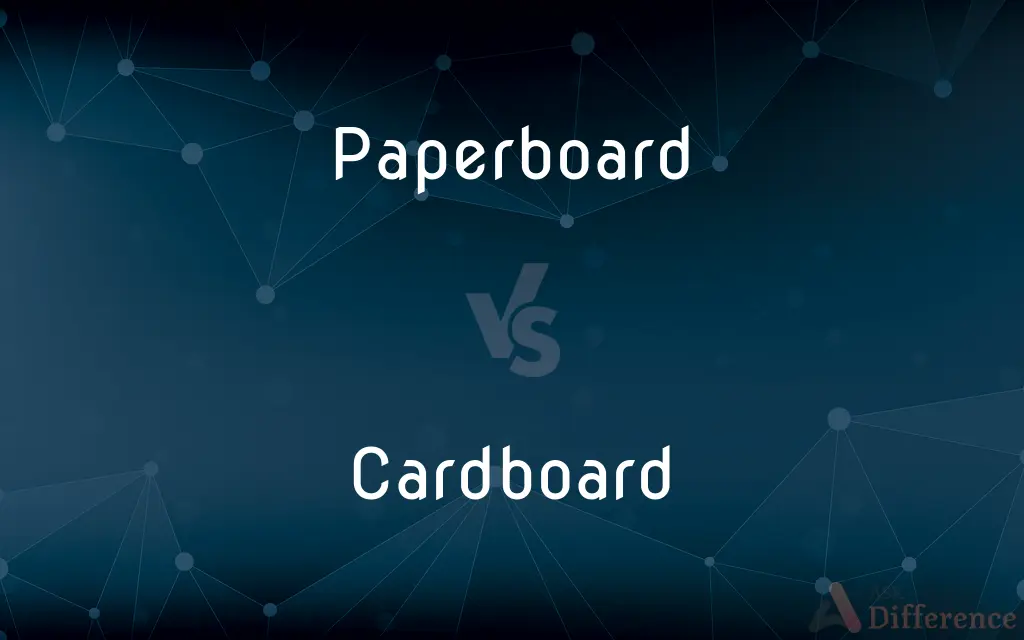Paperboard vs. Cardboard — What's the Difference?
By Fiza Rafique & Maham Liaqat — Updated on April 2, 2024
Paperboard is a thick, sturdy paper material used in packaging and creating products like cereal boxes, while cardboard refers to a heavier-duty material composed of multiple layers, including corrugated fiberboard, used for shipping boxes.

Difference Between Paperboard and Cardboard
Table of Contents
ADVERTISEMENT
Key Differences
Paperboard, a thick paper-based material, is often used in consumer goods packaging, such as cereal boxes, medicine boxes, and other retail packages. It's characterized by its single layer of heavy paper, offering a balance between durability and pliability. Cardboard, on the other hand, typically refers to a heavier, more robust material that includes several layers of paper with a corrugated layer in the middle, known as corrugated cardboard, used for shipping boxes and packaging that requires greater strength and durability.
The manufacturing process of paperboard involves pressing and drying fibrous material into a single, flat sheet, resulting in a smooth and uniform surface ideal for printing and graphic designs. Whereas cardboard production, especially corrugated cardboard, involves sandwiching a corrugated or fluted layer between two flat linerboards, providing superior strength and cushioning properties. This structure makes cardboard an excellent choice for protecting goods during transportation.
Paperboard is favored for its printability and ease of cutting and forming, making it suitable for a wide range of packaging designs, from simple shapes to complex structures. Cardboard's layered construction, while also printable, is more focused on structural integrity and protection, limiting its flexibility in intricate design but enhancing its utility in shipping and handling.
Environmental considerations play a significant role in the choice between paperboard and cardboard. Both materials are recyclable, but their recycling processes differ due to their structural compositions. Paperboard's single-layer makeup generally allows for straightforward recycling, whereas cardboard's multi-layered structure requires separation of the corrugated middle layer from the linerboards.
Despite their differences, both paperboard and cardboard are crucial in the packaging industry, chosen based on the specific needs of the product being packaged or shipped. Paperboard's sleek appearance and ease of customization make it ideal for consumer-facing packages, while cardboard's strength and durability ensure the safe transportation of goods.
ADVERTISEMENT
Comparison Chart
Composition
Single layer of heavy paper
Multiple layers, including a corrugated layer
Usage
Packaging for consumer goods (e.g., cereal boxes)
Shipping and protective packaging (e.g., shipping boxes)
Manufacturing Process
Pressed and dried into a flat sheet
Involves layering and corrugating for added strength
Strength & Durability
Moderately strong, suitable for retail packaging
Very strong, designed for shipping and protection
Printability
High, ideal for detailed graphics and designs
Moderate, suitable for branding but focused on strength
Compare with Definitions
Paperboard
A thick, flat material made from compressed paper fibers.
The new cereal box was made of sturdy paperboard.
Cardboard
Corrugated layer offers cushioning to protect contents.
The cardboard's corrugated middle layer absorbed shock during transit.
Paperboard
Used for consumer packaging due to its printability.
The cosmetic company chose paperboard for its vibrant package designs.
Cardboard
A heavier material made of several paper layers, including corrugated.
The online retailer shipped products in durable cardboard boxes.
Paperboard
Can be easily cut and formed into various shapes.
Designers created a unique paperboard display for the product launch.
Cardboard
More robust than paperboard, suitable for heavy or fragile items.
The electronics were packaged in reinforced cardboard for extra protection.
Paperboard
Recyclable, making it an eco-friendly packaging option.
The company highlighted its commitment to sustainability by using recyclable paperboard.
Cardboard
Widely recycled, contributing to environmental sustainability.
Customers were encouraged to recycle their cardboard packaging.
Paperboard
Offers a balance between strength and flexibility.
Paperboard was the perfect material for the foldable gift boxes.
Cardboard
Provides superior protection and strength for shipping.
The fragile items were secured in thick cardboard with cushioning.
Paperboard
Paperboard is a thick paper-based material. While there is no rigid differentiation between paper and paperboard, paperboard is generally thicker (usually over 0.30 mm, 0.012 in, or 12 points) than paper and has certain superior attributes such as foldability and rigidity.
Cardboard
Cardboard is a generic term for heavy-duty paper-based products having greater thickness and superior durability or other specific mechanical attributes to paper; such as foldability, rigidity and impact resistance. The construction can range from a thick sheet known as paperboard to corrugated fiberboard which is made of multiple corrugated and flat layers.
Paperboard
Cardboard; pasteboard.
Cardboard
A material similar to thick, stiff paper, that is made of pressed paper pulp or pasted sheets of paper. It is used for making cartons and signs, for example.
Paperboard
A thick paper, or thin cardboard.
Cardboard
Made of or consisting of cardboard.
Paperboard
A cardboard suitable for making posters
Cardboard
Flimsy; insubstantial.
Cardboard
Lacking depth; superficial
A movie with only cardboard caricatures of its historical subjects.
Cardboard
A wood-based material resembling heavy paper, used in the manufacture of boxes, cartons and signs.
Cardboard
Made of or resembling cardboard; (figurative) flat or flavorless.
Cardboard
A stiff compact pasteboard of various qualities, for making cards, etc., often having a polished surface.
Cardboard
A stiff moderately thick paper
Cardboard
Resembling cardboard especially in flimsiness;
Apartments with cardboard walls
Cardboard
Without substance;
Cardboard caricatures of historical figures
Common Curiosities
Can paperboard and cardboard be used interchangeably?
While both are used in packaging, their specific uses depend on the required strength and design needs. Cardboard is preferred for shipping, while paperboard is chosen for consumer packaging.
Are paperboard and cardboard recyclable?
Yes, both materials are recyclable, though the recycling process may vary due to their structural differences.
Why is cardboard often used for shipping boxes?
Its multi-layered structure, including a corrugated layer, provides the strength and cushioning needed to protect items during transportation.
Is there a visual difference between paperboard and cardboard?
Yes, paperboard generally has a smoother, uniform appearance, while cardboard features a corrugated layer visible at the edges.
Can cardboard be printed on like paperboard?
Cardboard can be printed on, but its surface may not be as suitable for detailed graphics as the smoother paperboard.
Do environmental concerns influence the choice between paperboard and cardboard?
Yes, both materials' recyclability and the sustainability of their production processes are important considerations.
Are there different types of paperboard and cardboard?
Yes, there are various grades and types of both, designed to meet specific packaging requirements.
Can paperboard be used for packaging heavy items?
Paperboard is typically used for lighter consumer goods due to its moderate strength. Heavy items may require the added durability of cardboard.
How are paperboard and cardboard produced?
Paperboard is made by pressing and drying fibrous material into a flat sheet, while cardboard is produced by layering and corrugating paper to add strength.
What makes corrugated cardboard ideal for shipping?
The corrugated layer provides shock absorption and strength, making it capable of handling the rigors of transport.
Is one more expensive to produce than the other?
The production cost can vary, with cardboard potentially being more expensive due to its more complex manufacturing process.
How does the weight of packaging material affect shipping costs?
Heavier materials like cardboard can increase shipping costs, but their protective qualities may outweigh the higher expense.
Can both paperboard and cardboard be customized in terms of shape and design?
Yes, both can be customized, but paperboard offers greater flexibility for intricate designs due to its easier cutting and folding properties.
How do manufacturers decide between using paperboard or cardboard?
The decision is based on the product's needs, including weight, fragility, and whether the packaging is consumer-facing or for shipping.
How is the environmental impact of these materials assessed?
The impact is assessed through their lifecycle, including production energy, recyclability, and the sustainability of the sourced fibers.
Share Your Discovery

Previous Comparison
Omentum vs. Mesentery
Next Comparison
Phallogocentrism vs. PhallocentrismAuthor Spotlight
Written by
Fiza RafiqueFiza Rafique is a skilled content writer at AskDifference.com, where she meticulously refines and enhances written pieces. Drawing from her vast editorial expertise, Fiza ensures clarity, accuracy, and precision in every article. Passionate about language, she continually seeks to elevate the quality of content for readers worldwide.
Co-written by
Maham Liaqat














































